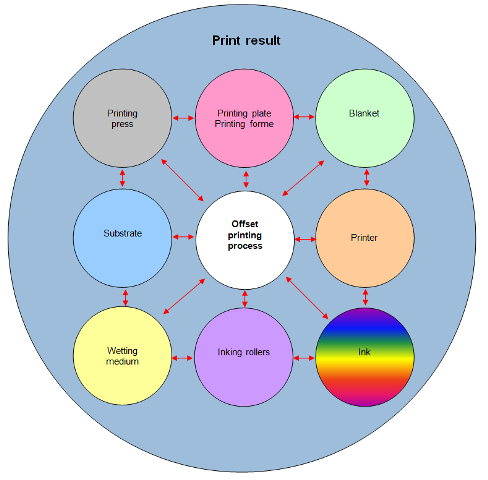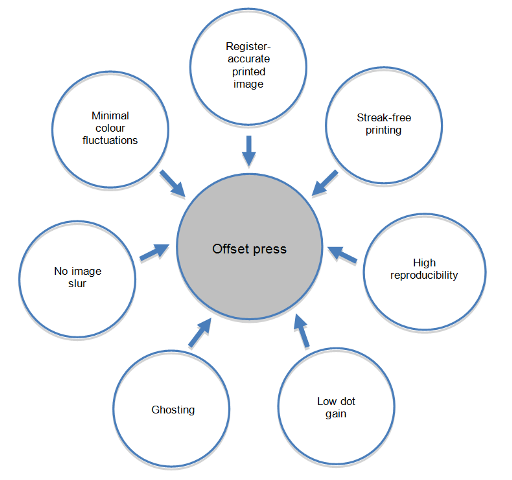Printing engineers are frequently involved in heated debate regarding the factors that influence the results achieved by a particular printing method, especially in offset printing. This debate largely centres on the press and the relevant printing process because this is where all the components needed for printing come together. However, the print result also always reflects the interplay between the materials and resources used and the operating personnel. This series of articles will explain the various factors separately and describe them in detail.
The diagram below shows the most important factors. The pressroom climate is an additional factor, but this will not be considered due to the significant regional differences.

Each of these factors has a significant impact on the print result and is directly linked to the other parameters.
Previous editions of Gallus in Touch have looked at the impact of the printing plate, blanket and rollers in the printing unit. The focus now turns to the actual press. Not only is an offset press subject to a number of different requirements, this is also where all the components – such as inks, printing plates and substrate – come together. They all have a significant impact on the print result.
How the printing press influences print quality
The most important requirements for an offset press:

Register-accurate printed image (register)
It must be possible to precisely align the inks printed in the printing units. Register accuracy must be ensured during the production run if a detailed printed image is to be printed in the correct position throughout the run. Register differences can also cause colour differences.
Colour fluctuations
Colour fluctuations during a production run must be minimised. Offset printing is more susceptible to such fluctuations than any other printing method. This is due to all kinds of parameters that can affect the balance between ink and damping medium. Press manufacturers do everything they can to minimise colour fluctuations. They do so, for example, by adjusting the number of rollers in the inking unit (ink reservoir) and using lateral distribution, distribution roller temperature control, etc. All settings in the printing unit must be very precise and need to be checked regularly.
No image slur
The printing units must not cause any image slur, i.e. the transfer between plate and blanket cylinders must always take place at the same position. Image slur also causes dot gain and colour differences in the printed image.
Ghosting
The printed image must not be subject to any reactions following the transfer of ink from the rollers to the printing forme. The inking unit, the number of application rollers and the printing forme have a significant impact on this. The setting of the wetting unit and the amount of wetting medium also play a very important role. Most offset printing units have setting options that eliminate these reactions or reduce them to an acceptable minimum.
Low dot gain
The dot gain in the printed image should be as low as possible. The lower the dot gain in the printing unit, the larger the range of tonal values that can be printed. There are a number of ways of reducing dot gain on the press, in particular ensuring correct unrolling of printing cylinders, setting the rollers and optimising printing pressure adjustment. Naturally, all the materials used – such as inks, printing plates, blanket and substrate – also play a key role. Foil substrates, for example, have a high dot gain, which makes optimum machine conditions particularly important in this case.
Streak-free printed image
Achieving a streak-free printed image is a big ask on an offset printing unit. It says something about the unit's stability and the design of the inking and damping units.
High reproducibility
High reproducibility demonstrates how quickly (time and paper waste) the correct colouring (matching the original) of the printed image can be achieved or how quickly the same colouring as for the first print can be achieved with repeat jobs. Today's presses have a large number of automatic functions to facilitate this process, such as ink zone remote control, the inking-up program, stored colour profiles, ink/water profiles, etc.
Conclusion
Many of the above-mentioned points interact and influence the printed image and its quality. The materials used – such as substrate, blanket, printing plate (prepress), inks and roller materials – must be precisely coordinated with each other and with the printing method to achieve the required printing quality. The entire workflow must be standardised to ensure the consistent quality necessary for every job. Effective and regular maintenance of printing units is also extremely important.